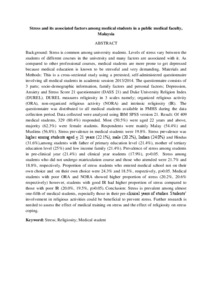Citation
N. M. Z., Anis and Pan, K. O. and Zainuddin, Huda and Ibrahim, Faisal
(2016)
Stress and its associated factors among medical students in a public medical faculty, Malaysia.
International Journal of Public Health and Clinical Sciences, 3 (3).
pp. 71-80.
ISSN 2289-7577
Abstract
Background: Stress is common among university students. Levels of stress vary between the students of different courses in the university and many factors are associated with it. As compared to other professional courses, medical students are more prone to get depressed because medical education is known to be stressful and very demanding. Materials and Methods: This is a cross-sectional study using a pretested, self-administered questionnaire involving all medical students in academic session 2013/2014. The questionnaire consists of 3 parts; socio-demographic information, family factors and personal factors; Depression, Anxiety and Stress Score 21 questionnaire (DASS 21) and Duke University Religion Index (DUREL). DUREL measures religiosity in 3 scales namely; organized religious activity (ORA), non-organized religious activity (NORA) and intrinsic religiosity (IR). The questionnaire was distributed to all medical students available in FMHS during the data collection period. Data collected were analyzed using IBM SPSS version 21. Result: Of 409 medical students, 329 (80.4%) responded. Most (50.5%) were aged 22 years and above, majority (62.3%) were female students. Respondents were mainly Malay (54.4%) and Muslims (56.8%). Stress prevalence in medical students were 19.8%. Stress prevalence was higher among students aged ≤ 21 years (22.1%), male (20.2%), Indian (24.0%) and Hindus (31.6%),among students with father of primary education level (21.4%), mother of tertiary education level (25%) and low income family (21.4%). Prevalence of stress among students in pre-clinical year (21.4%) and clinical year students (17.9%), p>0.05. Stress among students who did not undergo matriculation course and those who attended were 21.7% and 18.8%, respectively. Proportion of stress students who entered medical school not on their own choice and on their own choice were 24.3% and 18.5%, respectively, p>0.05. Medical students with poor ORA and NORA showed higher proportion of stress (20.2%, 20.6% respectively) however, students with good IR had higher proportion of stress compared to those with poor IR (20.0%, 19.5%, p>0.05). Conclusion: Stress is prevalent among almost one-fifth of medical students, especially those in their pre-clinical years of studies. Students’ involvement in religious activities could be beneficial to prevent stress. Further research is needed to assess the effect of medical training on stress and the effect of religiosity on stress coping.
Download File
![[img]](http://psasir.upm.edu.my/53900/1.hassmallThumbnailVersion/Stress%20and%20its%20associated%20factors%20among%20medical%20students%20in%20a%20public%20medical%20faculty%2C%20Malaysia.pdf)  Preview |
|
Text
Stress and its associated factors among medical students in a public medical faculty, Malaysia.pdf
Download (78kB)
| Preview
|
|
Additional Metadata
Actions (login required)
 |
View Item |

